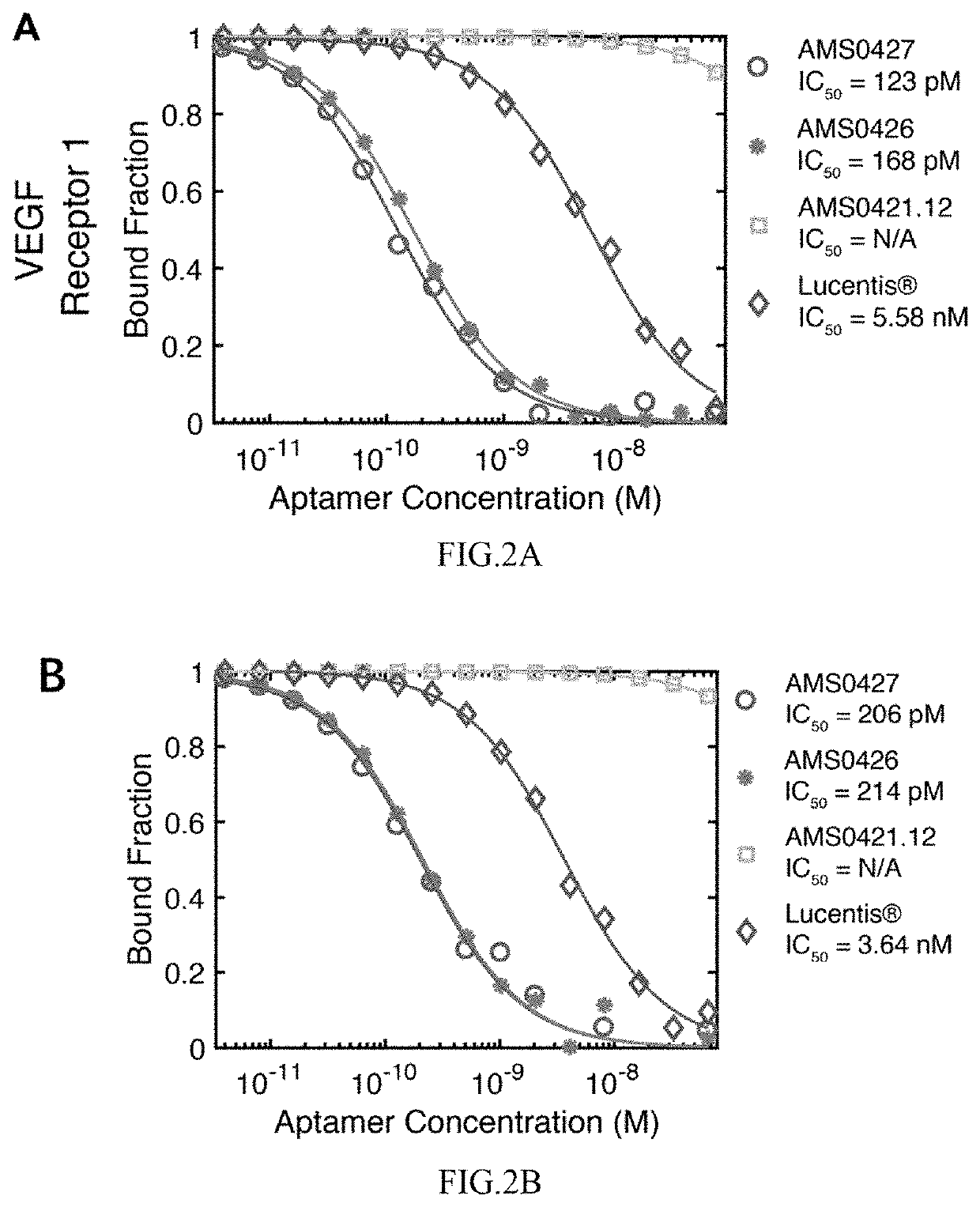Aptamers and use thereof
a technology of aptamers and adsorbents, applied in the field of aptamers and use thereof, can solve the problems of not being able to realize the potential of macugen®, not being able to recognize all vegfa isoforms, and still suffering from limited efficacy and duration, so as to reduce neovascularization and reduce vascular permeability
- Summary
- Abstract
- Description
- Claims
- Application Information
AI Technical Summary
Benefits of technology
Problems solved by technology
Method used
Image
Examples
example 1
Anti-VEGF Aptamer Selection
[0628]The anti-VEGF aptamers of the present disclosure were identified using Chemically-Augmented Particle Display (CAPD), a platform as described (please refers to Wang et al. WO 2018064086A1; Wang et al. WO2018102115A1; Wang et al. PCT / US2013 / 071318). Detailed methods and steps were as described in e.g., WO 2018064086A1, which is incorporated herein by reference in its entirety.
[0629]Briefly, recombinant human VEGF-121 and VEGF-165 protein from various vendors (listed in Table 1 were used as the target protein for aptamer discovery. A typical initial selection library contains a 40-50 nucleotide random region in which all nucleotides containing a 2′-fluoro (2′-F) modification. For example, for the selection against human VEGF-121 (R&D systems, 4644-vs-CF), the forward primer used was 5′-CGCCCTCGTCCCATCTC-3′(SEQ ID NO: 134) and the reverse primer used was 5′-CGTTCTCGGTTGGTGTTC-3′(SEQ ID NO: 135).
TABLE 1Recombinant VEGFA Proteins for Aptamer SelectionsCata...
example 2
Anti-VEGF Aptamer Identification and Truncation
[0636]Truncated and modified variants of the anti-VEGF aptamers of the present disclosure were prepared by LGC Biosearch Technologies (Novato, Calif.), and their binding affinity to corresponding targets were examined. Briefly, the equilibrium binding constants of the enriched libraries were measured using magnetic bead partitioning. Biotinylated anti-VEGF aptamers were conjugated to the 1 μm streptavidin-coated MyOne Streptavidin Cl magnetic beads (Thermo Fisher Scientific, 65002). Binding assays were performed by incubating fixed concentration of anti-VEGF aptamer (0.01 nM) and target protein at concentrations ranging from 10−12 to 10−8 M in PBSMCT buffer (DPBS, pH 7.2 with 2.5 mM MgCl2, 1 mM CaCl2) and 0.01% TWEEN-20) at 37° C. for 90 minutes. Bound target protein was partitioned by magnetic separation and subsequently labeled via fluorescent anti-VEGF or anti-His-tag antibody. The fraction of anti-VEGF aptamer bound was quantified b...
example 3
Anti-VEGF Aptamer In Vitro VEGF-R Competition Assays
[0642]To demonstrate that the anti-VEGF aptamers of the present disclosure are potent inhibitors of vascular endothelial growth factor-A (VEGF) signaling, in vitro competition assays were performed to verify that selected anti-VEGF aptamers can block the interaction between VEGFA and VEGF-R (such as VEGF-R1 and VEGF-R2). Three different recombinant VEGF receptors (two VEGF-R1 and one VEGF-R2) were tested (R&D Systems, 3516-FL, 321-FL, and 357-KD). For determination of the receptor competition IC50, 0.1 nM of VEGF-121 or VEGF-165 with His tag was conjugated to Dynabeads His-Tag Isolation and Pulldown beads (Thermo Fisher Scientific, 10104D), and then incubated with 1 nM of VEGF receptor and aptamers at concentrations ranging from 10−12 to 10−8 M in PBSMCT buffer (DPBS, pH 7.2 with 2.5 mM MgCl2, 1 mM CaCl2 and 0.01% TWEEN-20) at 37° C. for 90 minutes. VEGF-bound receptors and anti-VEGF aptamers were partitioned by magnetic separation...
PUM
| Property | Measurement | Unit |
|---|---|---|
| molecular weight | aaaaa | aaaaa |
| concentration | aaaaa | aaaaa |
| concentration | aaaaa | aaaaa |
Abstract
Description
Claims
Application Information
 Login to View More
Login to View More - R&D
- Intellectual Property
- Life Sciences
- Materials
- Tech Scout
- Unparalleled Data Quality
- Higher Quality Content
- 60% Fewer Hallucinations
Browse by: Latest US Patents, China's latest patents, Technical Efficacy Thesaurus, Application Domain, Technology Topic, Popular Technical Reports.
© 2025 PatSnap. All rights reserved.Legal|Privacy policy|Modern Slavery Act Transparency Statement|Sitemap|About US| Contact US: help@patsnap.com



